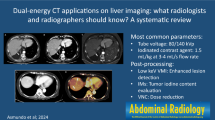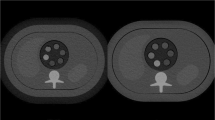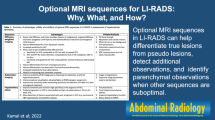Abstract
Objective
To assess parenchymal bolus-triggering in terms of liver enhancement, lesion-to-liver conspicuity and inter-image variability across serial follow-up MDCTs.
Methods
We reviewed MDCTs of 50 patients with hepatic metastases who had a baseline CT and two follow-up examinations. In 25 consecutive patients CT data acquisition was initiated by liver parenchyma triggering at a 50-HU enhancement threshold. In a matched control group, imaging was performed with an empirical delay of 65 s. CT attenuation values were assessed in vessels, liver parenchyma and metastasis. Target lesions were classified according to five enhancement patterns.
Results
Compared with the control group, liver enhancement was significantly higher with parenchyma triggering (59.8 ± 7.6 HU vs. 48.8 ± 11.2 HU, P = 0.0002). The same was true for conspicuity (liver parenchyma – lesion attenuation) of hypo-enhancing lesions (72.2 ± 15.9 HU vs. 52.7 ± 19.4 HU, P = 0.0006). Liver triggering was associated with reduced variability for liver enhancement among different patients (P = 0.035) and across serial follow-up examinations in individual patients (P < 0.0001). The number of patients presenting with uniform lesion enhancement pattern across serial examinations was significantly higher in the triggered group (20 vs. 11; P = 0.018).
Conclusion
Liver parenchyma triggering provides superior lesion conspicuity and improves standardisation of image quality across follow-up examinations with greater uniformity of enhancement patterns.
Key Points
• Liver parenchyma tracking improves liver enhancement and lesion-to-liver conspicuity in abdominal CT
• In serial CT studies this technique reduces variability of conspicuity and enhancement patterns
• Higher liver-to-lesion conspicuity is a prerequisite for reliable detection of liver lesions
• Stabilisation of enhancement permits more accurate follow-up of oncology patients






Similar content being viewed by others
References
Baker ME, Pelley R (1995) Hepatic metastases: basic principles and implications for radiologists. Radiology 197:329–337
Bae KT. Intravenous contrast medium administration and scan timing at CT: considerations and approaches. Radiology 256:32–61
Blake SP, Weisinger K, Atkins MB, Raptopoulos V (1999) Liver metastases from melanoma: detection with multiphasic contrast-enhanced CT. Radiology 213:92–96
Francis IR, Cohan RH, McNulty NJ et al (2003) Multidetector CT of the liver and hepatic neoplasms: effect of multiphasic imaging on tumour conspicuity and vascular enhancement. AJR Am J Roentgenol 180:1217–1224
Frederick MG, Paulson EK, Nelson RC (1997) Helical CT for detecting focal liver lesions in patients with breast carcinoma: comparison of noncontrast phase, hepatic arterial phase, and portal venous phase. J Comput Assist Tomogr 21:229–235
Oliver JH 3rd, Baron RL (1996) Helical biphasic contrast-enhanced CT of the liver: technique, indications, interpretation, and pitfalls. Radiology 201:1–14
Oliver JH 3rd, Baron RL, Federle MP, Jones BC, Sheng R (1997) Hypervascular liver metastases: do unenhanced and hepatic arterial phase CT images affect tumour detection? Radiology 205:709–715
Raptopoulos VD, Blake SP, Weisinger K, Atkins MB, Keogan MT, Kruskal JB (2001) Multiphase contrast-enhanced helical CT of liver metastases from renal cell carcinoma. Eur Radiol 11:2504–2509
Bae KT, Heiken JP, Brink JA (1998) Aortic and hepatic contrast medium enhancement at CT. Part II. Effect of reduced cardiac output in a porcine model. Radiology 207:657–662
Heiken JP, Brink JA, McClennan BL, Sagel SS, Crowe TM, Gaines MV (1995) Dynamic incremental CT: effect of volume and concentration of contrast material and patient weight on hepatic enhancement. Radiology 195:353–357
Kormano M, Partanen K, Soimakallio S, Kivimaki T (1983) Dynamic contrast enhancement of the upper abdomen: effect of contrast medium and body weight. Invest Radiol 18:364–367
Dinkel HP, Fieger M, Knupffer J, Moll R, Schindler G (1998) Optimizing liver contrast in helical liver CT: value of a real-time bolus-triggering technique. Eur Radiol 8:1608–1612
Kopka L, Funke M, Fischer U, Vosshenrich R, Oestmann JW, Grabbe E (1995) Parenchymal liver enhancement with bolus-triggered helical CT: preliminary clinical results. Radiology 195:282–284
Silverman PM, Roberts S, Tefft MC et al (1995) Helical CT of the liver: clinical application of an automated computer technique, SmartPrep, for obtaining images with optimal contrast enhancement. AJR Am J Roentgenol 165:73–78
Silverman PM, Roberts SC, Ducic I et al (1996) Assessment of a technology that permits individualized scan delays on helical hepatic CT: a technique to improve efficiency in use of contrast material. AJR Am J Roentgenol 167:79–84
Mehnert F, Pereira PL, Trubenbach J, Kopp AF, Claussen CD (2001) Automatic bolus tracking in monophasic spiral CT of the liver: liver-to-lesion conspicuity. Eur Radiol 11:580–584
Zamboni GA, Gourtsoyianni S, Sourlas E, Raptopoulos VD (2009) Value of customized scan timing determined by tracking liver enhancement in oncology patients. J Comput Assist Tomogr 33:253–258
Baron RL (1994) Understanding and optimizing use of contrast material for CT of the liver. AJR Am J Roentgenol 163:323–331
Berland LL, Lawson TL, Foley WD, Melrose BL, Chintapalli KN, Taylor AJ (1982) Comparison of pre- and postcontrast CT in hepatic masses. AJR Am J Roentgenol 138:853–858
Foley WD, Berland LL, Lawson TL, Smith DF, Thorsen MK (1983) Contrast enhancement technique for dynamic hepatic computed tomographic scanning. Radiology 147:797–803
Nazarian LN, Park JH, Halpern EJ et al (1999) Size of colorectal liver metastases at abdominal CT: comparison of precontrast and postcontrast studies. Radiology 213:825–830
Paulson EK, McDermott VG, Keogan MT, DeLong DM, Frederick MG, Nelson RC (1998) Carcinoid metastases to the liver: role of triple-phase helical CT. Radiology 206:143–150
Walkey MM (1991) Dynamic hepatic CT: how many years will it take 'til we learn? Radiology 181:17–18
Young SW, Turner RJ, Castellino RA (1980) A strategy for the contrast enhancement of malignant tumours using dynamic computed tomography and intravascular pharmacokinetics. Radiology 137:137–147
Awai K, Hiraishi K, Hori S (2004) Effect of contrast material injection duration and rate on aortic peak time and peak enhancement at dynamic CT involving injection protocol with dose tailored to patient weight. Radiology 230:142–150
Brink JA, Heiken JP, Forman HP, Sagel SS, Molina PL, Brown PC (1995) Hepatic spiral CT: reduction of dose of intravenous contrast material. Radiology 197:83–88
Goshima S, Kanematsu M, Kondo H et al (2006) MDCT of the liver and hypervascular hepatocellular carcinomas: optimizing scan delays for bolus-tracking techniques of hepatic arterial and portal venous phases. AJR Am J Roentgenol 187:W25–32
Itoh S, Ikeda M, Achiwa M, Satake H, Iwano S, Ishigaki T (2004) Late-arterial and portal-venous phase imaging of the liver with a multislice CT scanner in patients without circulatory disturbances: automatic bolus tracking or empirical scan delay? Eur Radiol 14:1665–1673
Kopka L, Funke M, Kruger M, Schroder T, Schulz R, Grabbe E (1994) Optimizing a contrast medium bolus in spiral CT. Rofo 160:361–363
Mehnert F, Pereira PL, Trubenbach J, Kopp AF, Claussen CD (2001) Biphasic spiral CT of the liver: automatic bolus tracking or time delay? Eur Radiol 11:427–431
Claussen CD, Banzer D, Pfretzschner C, Kalender WA, Schorner W (1984) Bolus geometry and dynamics after intravenous contrast medium injection. Radiology 153:365–368
Dean PB, Violante MR, Mahoney JA (1980) Hepatic CT contrast enhancement: effect of dose, duration of infusion, and time elapsed following infusion. Invest Radiol 15:158–161
Dodd GD 3rd, Baron RL (1993) Investigation of contrast enhancement in CT of the liver: the need for improved methods. AJR Am J Roentgenol 160:643–645
Sheafor DH, Keogan MT, DeLong DM, Nelson RC (1998) Dynamic helical CT of the abdomen: prospective comparison of pre- and postprandial contrast enhancement. Radiology 206:359–363
Vignaux O, Legmann P, Coste J, Hoeffel C, Bonnin A (1999) Cirrhotic liver enhancement on dual-phase helical CT: comparison with noncirrhotic livers in 146 patients. AJR Am J Roentgenol 173:1193–1197
Cox IH, Foley WD, Hoffmann RG (1991) Right window for dynamic hepatic CT. Radiology 181:18–21, discussion 21–14
Therasse P, Arbuck SG, Eisenhauer EA et al (2000) New guidelines to evaluate the response to treatment in solid tumours. European Organization for Research and Treatment of Cancer, National Cancer Institute of the United States, National Cancer Institute of Canada. J Natl Cancer Inst 92:205–216
Bechtold RE, Chen MY, Stanton CA, Savage PD, Levine EA (2003) Cystic changes in hepatic and peritoneal metastases from gastrointestinal stromal tumours treated with Gleevec. Abdom Imaging 28:808–814
Benjamin RS, Choi H, Macapinlac HA et al (2007) We should desist using RECIST, at least in GIST. J Clin Oncol 25:1760–1764
Sica GT (2006) Bias in research studies. Radiology 238:780–789
Acknowledgements
Vassilios Raptopoulos is recipient of a grant from Toshiba America Medical Systems.
Author information
Authors and Affiliations
Corresponding author
Rights and permissions
About this article
Cite this article
Brodoefel, H., Tognolini, A., Zamboni, G.A. et al. Standardisation of liver MDCT by tracking liver parenchyma enhancement to trigger imaging. Eur Radiol 22, 812–820 (2012). https://doi.org/10.1007/s00330-011-2310-4
Received:
Revised:
Accepted:
Published:
Issue Date:
DOI: https://doi.org/10.1007/s00330-011-2310-4




